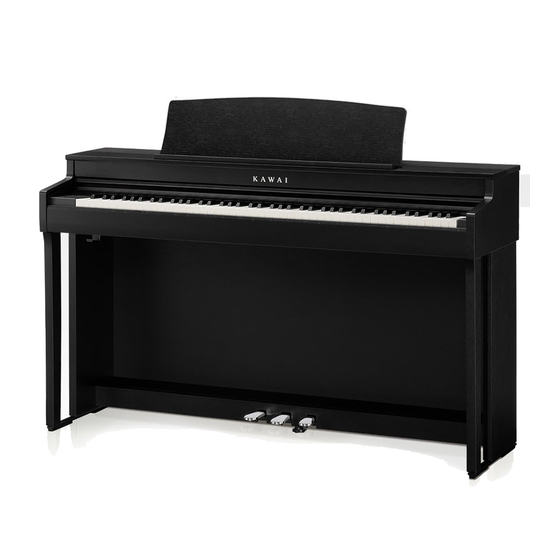
Table of Contents
Advertisement
Quick Links
CN301 MIDI Settings Manual
The term MIDI is an acronym for Musical Instrument Digital Interface, an international standard for con-
necting musical instruments, computers, and other devices to allow the exchange of performance data.
When the instrument is connected to a computer using a USB cable, the computer will recognise the in-
strument as a MIDI device, allowing the instrument to send and receive MIDI messages in the same man-
ner as a normal MIDI interface.
Use a suitable USB cable to connect the USB type A port on the computer to the USB type B port on the
digital piano. If there is no USB type A port on the computer, a conversion adapter may be required.
▋ MIDI use case
When connected to a computer, the digital piano can be used to
record and playback performances using sequencer software
running on the computer. When multi-timbral mode is enabled
on the digital piano, it becomes possible to record and playback
multi-track songs, with different sounds playing simultaneously
on each MIDI channel.
P4
Multi-timbral Mode
▋ MIDI functions
The following functions are available with MIDI.
Transmit/receive note information
Transmit/receive note information from a MIDI-connected
musical instrument or device.
Transmit/receive Program Change number
Transmit/receive program change data to/from a MIDI con-
nected musical instrument or device.
Transmit/receive pedal data
Transmit/receive sustain, sostenuto, and soft pedal data from
a MIDI-connected musical instrument or device.
Receive volume data
Receive MIDI volume data sent from a MIDI-connected musi-
cal instrument or device.
Copyright notice
Pieces of music based on existing works such as CDs, music files, SMF data, etc. should only be used for private listening, and for en-
joying with friends and family. According to copyright law, it is not permitted to play commercial music publicly without permission
from the copyright owner. Kawai is not liable for any copyright law infringement committed by the digital piano user.
P8
MIDI Implementation Chart
"MIDI" is a registered trademark of the Association of
Musical Electronics Industry.
USB type "B"
Transmit/receive channel settings
Specify transmit/receive channels within the range of 1 to 16.
Multi-timbral mode setting
Receive multiple channel MIDI data from a MIDI-connected
musical instrument or device.
* Multi-timbral mode setting must be enabled.
Transmit/receive exclusive data
Transmit/receive front panel or menu function settings as ex-
clusive data.
1
USB type "A"
Advertisement
Table of Contents

Summary of Contents for Kawai CN301
- Page 1 According to copyright law, it is not permitted to play commercial music publicly without permission from the copyright owner. Kawai is not liable for any copyright law infringement committed by the digital piano user. MIDI Implementation Chart “MIDI”...
-
Page 2: Midi Channel
▋ MIDI settings Function name Explanation Default setting MIDI Channel This setting allows the transmit/receive channel to be specifi ed. The selected channel will function as both the transmit and receive channel. Separate trans- mit/receive channels cannot be specifi ed. Transmit Program Change This function is used to transmit a program change number (ranging from 1 to Number... -
Page 3: Local Control
Omni mode When the digital piano is turned on, the instrument is automatically set to “omni mode on”, allowing MIDI information to be received on all MIDI channels (1~16). When the MIDI Channel setting is used to specify a transmit/receive channel, the instrument will be set to “omni mode off”. -
Page 4: Multi-Timbral Mode
Multi-timbral Mode ▋ Setting Multi-timbral Mode With “Multi Timbre” selected, press the [LEFT]/[RIGHT] button to select “On1”, “On2, or “Off”. When “On1” or “Off” is set: The sound corresponding to the number on the left of “Program Change Number List” is selected. When “On2”... - Page 5 ▋ Program Change Number List Multi-timbral mode Multi-timbral mode = on2 = off/on1 Sound name Program number Program number Bank MSB Bank LSB PIANO1 SK-EX Concert Grand Piano | Concert EX Concert Grand Piano | Concert SK-5 Grand Piano | Classic SK-EX Concert Grand Piano | Jazz EX Concert Grand Piano | Standard SK-EX Concert Grand Piano | Mellow...
- Page 6 ▋ Program Change Number List (Played only when receiving MIDI) Multi-timbral mode Multi-timbral mode = on2 = off/on1 Sound name Program number Program number Bank MSB Bank LSB Glockenspiel Music Box Xylophone Tubular Bells Church Bells Rock Organ Accordion Harmonica Nylon Acoustic Guitar Modern Jazz Guitar Muted Electric Guitar...
-
Page 7: Midi Exclusive Data Format
00 - 0F MIDI channel 10, 30 Function code (30 when setting Multi-timbre On/Off ) Indicates that the instrument is an electric piano Indicates that the piano is a CN301 model data 1 data 2 See table below data 3... -
Page 8: Midi Implementation Chart
MIDI Implementation Chart Date : June 2022 Version : 1.0 Function Transmit Receive Remarks At power-up Basic channel Settable 1 - 16 1 - 16 At power-up Mode 3 Mode 1 Omni mode is on at power-up. Mode Message Mode 1, 3 Omni mode can be turned off through MIDI channel setting operations.










Need help?
Do you have a question about the CN301 and is the answer not in the manual?
Questions and answers